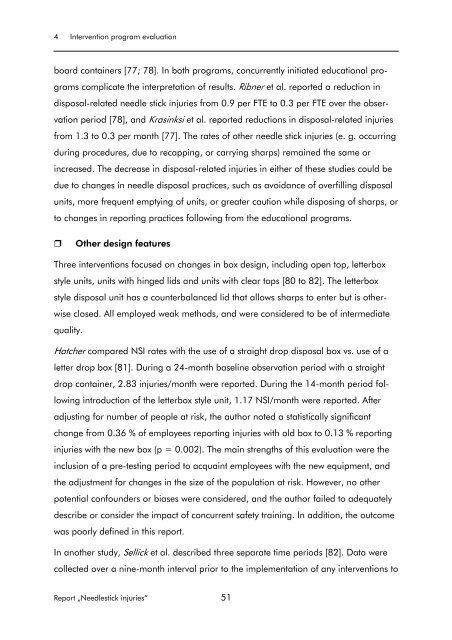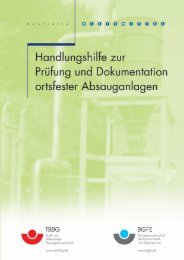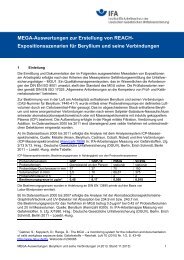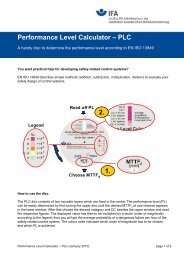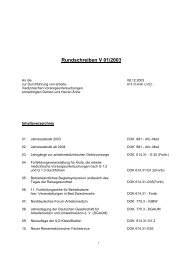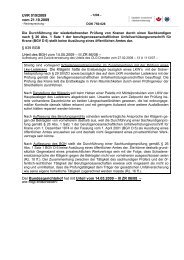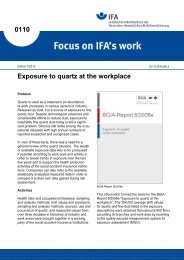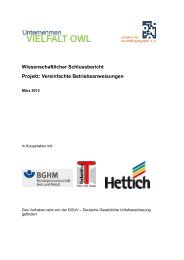Effectiveness of measures to prevent needlestick injuries among ...
Effectiveness of measures to prevent needlestick injuries among ...
Effectiveness of measures to prevent needlestick injuries among ...
Create successful ePaper yourself
Turn your PDF publications into a flip-book with our unique Google optimized e-Paper software.
4 Intervention program evaluation<br />
board containers [77; 78]. In both programs, concurrently initiated educational pro-<br />
grams complicate the interpretation <strong>of</strong> results. Ribner et al. reported a reduction in<br />
disposal-related needle stick <strong>injuries</strong> from 0.9 per FTE <strong>to</strong> 0.3 per FTE over the obser-<br />
vation period [78], and Krasinksi et al. reported reductions in disposal-related <strong>injuries</strong><br />
from 1.3 <strong>to</strong> 0.3 per month [77]. The rates <strong>of</strong> other needle stick <strong>injuries</strong> (e. g. occurring<br />
during procedures, due <strong>to</strong> recapping, or carrying sharps) remained the same or<br />
increased. The decrease in disposal-related <strong>injuries</strong> in either <strong>of</strong> these studies could be<br />
due <strong>to</strong> changes in needle disposal practices, such as avoidance <strong>of</strong> overfilling disposal<br />
units, more frequent emptying <strong>of</strong> units, or greater caution while disposing <strong>of</strong> sharps, or<br />
<strong>to</strong> changes in reporting practices following from the educational programs.<br />
� Other design features<br />
Three interventions focused on changes in box design, including open <strong>to</strong>p, letterbox<br />
style units, units with hinged lids and units with clear <strong>to</strong>ps [80 <strong>to</strong> 82]. The letterbox<br />
style disposal unit has a counterbalanced lid that allows sharps <strong>to</strong> enter but is other-<br />
wise closed. All employed weak methods, and were considered <strong>to</strong> be <strong>of</strong> intermediate<br />
quality.<br />
Hatcher compared NSI rates with the use <strong>of</strong> a straight drop disposal box vs. use <strong>of</strong> a<br />
letter drop box [81]. During a 24-month baseline observation period with a straight<br />
drop container, 2.83 <strong>injuries</strong>/month were reported. During the 14-month period fol-<br />
lowing introduction <strong>of</strong> the letterbox style unit, 1.17 NSI/month were reported. After<br />
adjusting for number <strong>of</strong> people at risk, the author noted a statistically significant<br />
change from 0.36 % <strong>of</strong> employees reporting <strong>injuries</strong> with old box <strong>to</strong> 0.13 % reporting<br />
<strong>injuries</strong> with the new box (p = 0.002). The main strengths <strong>of</strong> this evaluation were the<br />
inclusion <strong>of</strong> a pre-testing period <strong>to</strong> acquaint employees with the new equipment, and<br />
the adjustment for changes in the size <strong>of</strong> the population at risk. However, no other<br />
potential confounders or biases were considered, and the author failed <strong>to</strong> adequately<br />
describe or consider the impact <strong>of</strong> concurrent safety training. In addition, the outcome<br />
was poorly defined in this report.<br />
In another study, Sellick et al. described three separate time periods [82]. Data were<br />
collected over a nine-month interval prior <strong>to</strong> the implementation <strong>of</strong> any interventions <strong>to</strong><br />
Report „Needlestick <strong>injuries</strong>“ 51


